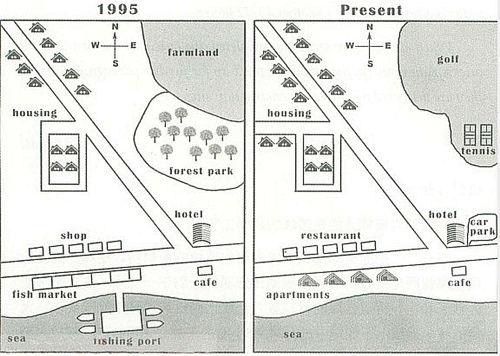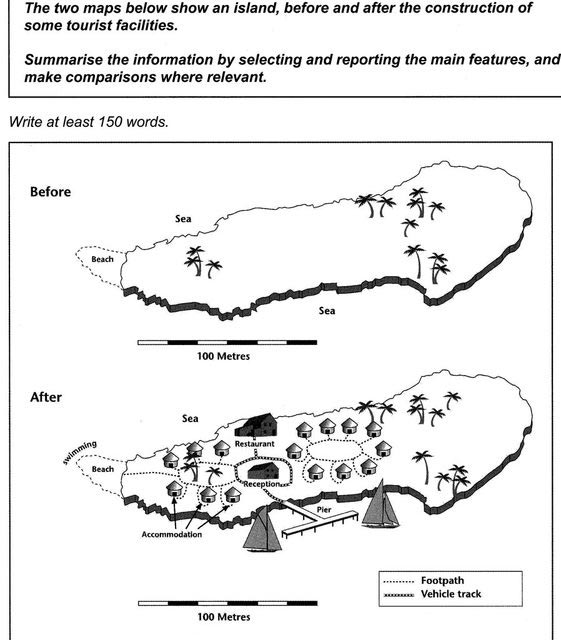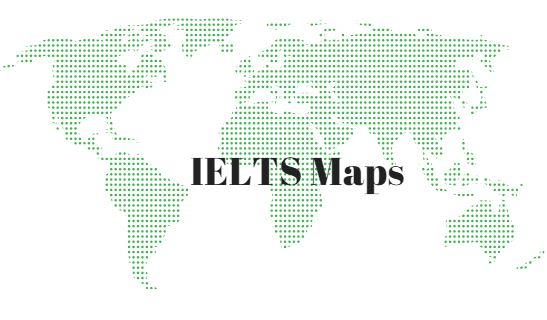Introduction
This guide on IELTS Writing Task 1 maps questions will cover:
- Different kinds of map question
- Structure
- Describing specific changes
- Describing general changes
- Describing locations
- Sample answer
You will also be able to learn some new vocabulary that will help you deal with any Task 1 maps question.
In the IELTS writing test, you might be asked to describe a map in task 1. This type of question is becoming increasingly popular- in fact, it was on the exam last weekend here in Vietnam- and in my opinion, the easiest one to score high marks in if you’re prepared.
Many students, books and teachers overlook this type of question, and it is, therefore, a bit of a shock when one comes up. Therefore, if you are prepared, you will probably do better than most of the other students.
Different Kinds of Map Question
There are three main types of map questions:
- Describe one map in the present day.
- Describe two maps- one in the present and one in the future.
- Describe two maps- one in the past and one in the present.
The first kind is very rare, as it only requires you to use the present simple, and no comparisons can be made.
The second kind occasionally comes up and requires you to use present and future tenses. This kind of question is normally about the future development of a town or city. It requires the same vocabulary as the other two.
The third is the most common and will be the main focus of this post.
You will normally be shown two maps, as above and asked to select and report the main features and make comparisons where relevant. You will obviously use both present and past tenses to describe the maps and how the town has developed.
Also, as this is a man-made process, we will use the passive.

Source: Cambridge English Practice Papers.
Structure
To describe two maps, I advise my students to follow a four-paragraph structure.
Paragraph 1- Paraphrase Sentence
Paraphrase question using synonyms.
Paragraph 2- Overview
Make two general statements about the map. You should describe the maps generally and write about the most noticeable differences between the two maps. You could ask yourself the following questions to identify general changes. Is the map more or less residential? Is there more or less countryside? Are there more or fewer trees? Were the changes dramatic or negligible? Were there any major infrastructure improvements? How have the buildings and leisure facilities changed?
Paragraph 3- Main Body 1
Three to four sentences about specific changes that have occurred.
Paragraph 4- Main Body 2
Further, three to four sentences about specific changes that have occurred.
You can group information in paragraphs 3 and 4 by time or location, depending on the question asked.
Look at the sample answer below to see how I have used this structure.
How to Describe Specific Changes
The ability to describe change is crucial to answering these questions. The various buildings and features will normally be labelled for you. You need to work on how to write about how they have changed from the past up until the present day.
Tip: You may be asked to describe your hometown in the speaking test. The vocabulary and grammar in this post should come in very useful.
Below I will list various buildings, features, and verbs we could use to describe their change.
Buildings– demolished, knocked down, flattened, replaced, renovated, built, constructed, reconstructed, developed, extended, expanded, relocated, converted and modernized.
Examples:
The government demolished the industrial estate and developed a sports ground.
They removed the shops and replaced them with a skyscraper.
A port was constructed at the edge of the river.
The factory in the city centre was demolished and relocated to the city’s north.
The old warehouses were replaced with new hotels.
The factory was converted into apartments.
Trees and Forests- cleared, cut down, chopped down, removed, planted.
Examples:
The forest was cut down and replaced with a shopping centre.
The trees were cleared to make way for houses.
Roads, bridges and railways lines- constructed, built, extended, expanded and removed.
The main road was extended, and a new bridge was built over the river.
Leisure facilities- opened, set up, developed.
Examples:
A skate park was set up next to the swimming pool.
A park was developed beside the forest.

How to Describe General Changes
As this is an IELTS writing task 1 question, we must write an overview, where we generally talk about the main changes between the two maps.
Below are some examples of general statements we could use to describe change in towns and cities.
- Over the period, the area witnessed dramatic changes.
- From 1995 to 2005, the city centre saw spectacular developments.
- The village changed considerably over the period.
- During the 10-year period, the industrial area was totally transformed.
- Over the past 20 years, the residential area was totally reconstructed.
- Over the period, the old docks were totally redeveloped.
- Between 1995 and 2005, the old houses were rebuilt.
- The central business district was completely modernised during the period.
Pick two or three of the most noticeable differences in the map and write a general statement for each. This will be your overview paragraph.
The more specific changes should be included in your main body paragraphs.
How to Describe Locations
You will also be expected to describe where things are maps and describe where changes have occurred.
You can use ‘to the left’ and ‘to the right’, but a better way is to use ‘north’, ‘south’, ‘east’ and ‘west’. I normally advise my students to draw the symbols on the question paper if they are not already there.
Examples:
The forest to the south of the river was cut down.
A golf course was constructed to the north of the airport.
The houses in the southwest of the town were demolished.
The green fields to the city’s northwest were redeveloped as a park.
The airport in the city’s centre was relocated to the northeast of the river.
The school to the southeast was knocked down and a new one was built to the east of the forest.
Finally, you will also be expected to use prepositions of place, e.g. at/in/on/by/beside/to/off/from, to describe where things are.
Examples:
Dramatic changes took place in the city centre.
To the town’s south is a golf course surrounded by trees.
A new school was built next to the swimming pool.
The old road running from north to south was replaced by a new motorway.
A marina was built on the banks of the river.
Sample Answer

Source: Cambridge English Practice Papers.
Both maps display an island before and after it was developed for tourism.
The island is approximately 250 metres long, has palm trees dotted around it, is surrounded by ocean and has a beach to the west. Over the period, the island was completely transformed with the addition of a hotel and a pier; however, the eastern part of the island appears to have been left undeveloped.
The most noticeable additions are the hotel rooms. 6 buildings, surrounding some trees, have been built in the west of the island, and 9 buildings have been constructed in the centre of the island. A reception building and a restaurant have been developed between the two accommodation areas.
A pier has also been built on the island’s south coast, allowing yachts access to the resort. Apart from the trees, the beach remains the only natural feature to remain relatively untouched; however, it appears to be used for swimming.
Next Steps
Do you need me to correct your essays and give you feedback on them? Check out our essay correction service.
I hope this lesson has helped you and if you have any questions, please comment below.


